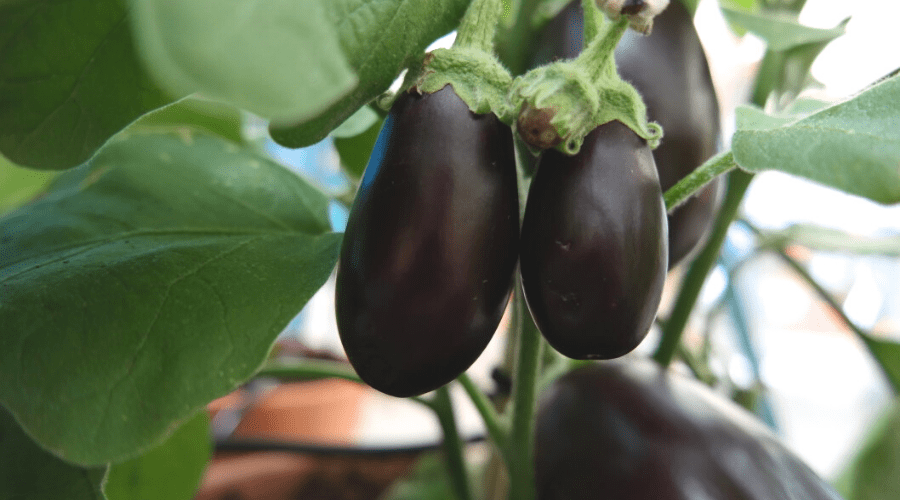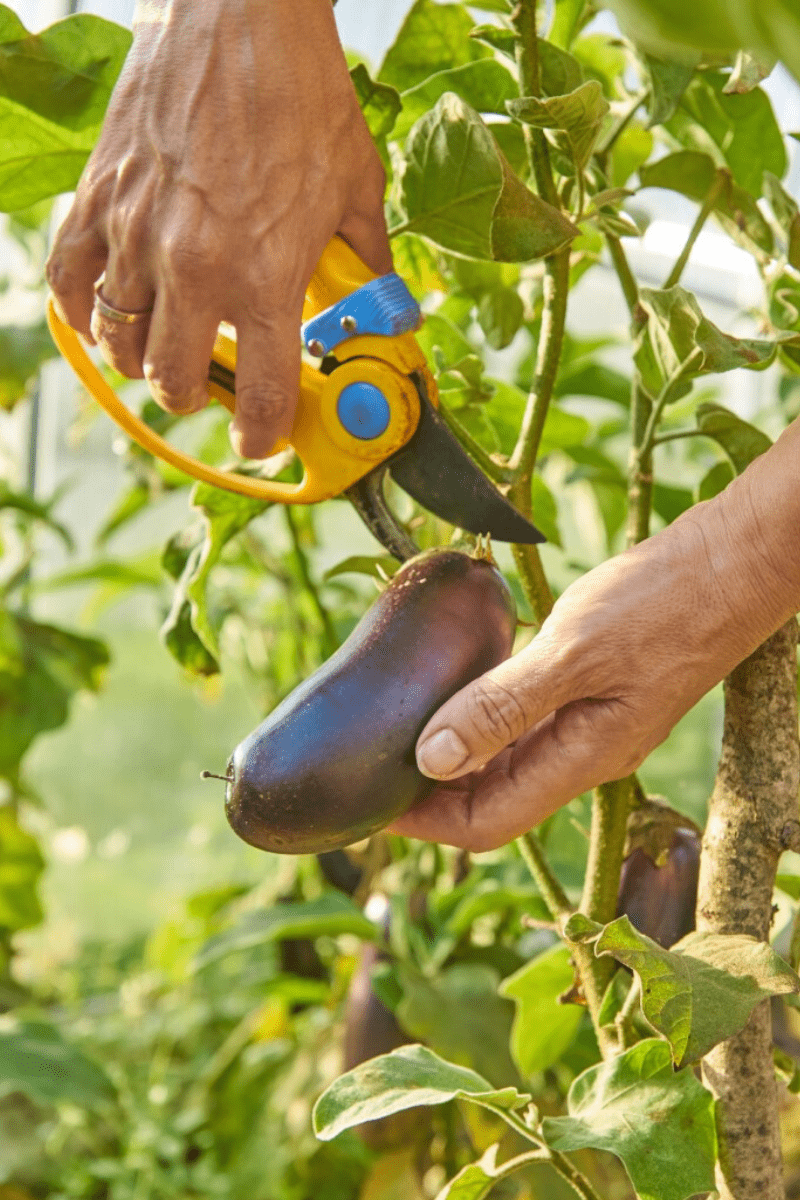Did you know that eggplants aren’t actually vegetables, but berries? Even more, they are actually related to the beloved tomato (which, as you know, isn’t a vegetable either, but a fruit). Vegetables or not, we do know that eggplants are really good for your health, as they are rich in antioxidants, are believed to reduce the risk of heart disease, and are believed to promote blood sugar control. So, what do you say; are you ready to learn how to grow your own eggplants?
Eggplant FAQ
How Long Does it Take to Grow an Eggplant?
This depends on how you grow the eggplants. For example, if you plant them in containers and keep them indoors for about 8 weeks and then transplant them into the ground, it usually takes about 65 to 80 days for the plants to reach maturity and for the fruits to be ready for harvest. If you grow eggplants from seeds, it usually takes between 100 and 120 days for the fruits to be of the proper size to be picked.
However, this also depends on the exact variety of eggplant that you want to plant. Some examples are Millionaire (takes about 50 to 55 days to reach maturity), Tango/Epic, Dusky (will reach maturity in 60 to 64 days), and Santana/Ghostbuster/Burpee Hybrid (reach maturity in about 73 to 80 days).
How Many Eggplants Do You Get Per Plant?
This depends on the variety of eggplants that you’re interested in growing. For example, you have Black Beauty, which is the traditional eggplant size and it can give you about 4 to 6 fruits per each plant.
Do Eggplants Need Support?
Yes. The fruit of eggplant is quite heavy, so if you don’t use stakes or cages to prevent the weight of the fruit from pulling down the plant and damaging it, you will end up feeling quite frustrated instead of being able to enjoy a weekly harvest.
How to Grow Eggplant
Rich in nutrients and part of many different dishes from around the world, eggplants are a great thing to include in your diet. If what we’ve previously said has sparked an interest in eating more eggplants, you’re probably wondering what are the steps to follow. So, how do you grow an eggplant step by step?
- The best way to grow eggplants is to plant them indoors about eight to nine weeks before the last spring frost date. The ideal temperature for seed germination is between 70 and 90°F. If this is too much trouble, you can always purchase nursery transplants and have them ready just before planting. Those of you that do decide to buy transplants should purchase high-quality ones.
- As far as soil is concerned, you will need well-drained sandy loam with plenty of organic matter if you want your eggplants to thrive. The pH of the soil should be between 5.8 and 6.5.
- Before transplanting the plants into the soil, feel free to use black plastic mulch covering to make sure the soil is warm enough for the eggplants.
- As for fertilizing, it’s best if you mix around one inch of well-rotted manure (general fertilizer should also do the trick) into the planting bed a week prior to transplanting.
- Eggplants will thrive if they are planted in a sunny spot. Those of you that plant this vegetable in pots should use a container of a dark color so that it can absorb more sunlight. Even those of you that plant in containers should place the containers outside in sunny spot so that they can pollinate.
- When you’re ready to begin the actual planting process, make sure that you set up the stakes right from the beginning so that the plant can climb, and you can prevent disturbing the soil later.
- Those of you that live in colder climates might want to invest in some row covers, as the plants need to stay warm to yield a beautiful and bountiful harvest. You can open the end of the covers when the temperatures outside are high enough so that bees may pollinate.
- Those of you that are transplanting should set 3 to 4-inch tall seedlings and place them in rows spaced at 3 to 4 feet apart from one another, with another 2 feet distance in between them on a single row.
- When you’re done plating the eggplants, water in abundance. You will also need to add a layer of mulch so that the soil can retain moisture and prevent weed formation.
- Since eggplants are quite heavy, the plant is likely to fall once fruits have reached maturity, which means that you will need stakes or cages to prevent this from happening. Those of you that grow eggplants in containers should stake the stems prior to fruit formation.
- If you want your plants to be bushier, you can pinch out terminal growth
- Watering eggplants can be a bit tricky because it has to be precise. You want the soil to be moist, but not soggy. To achieve this, you can water about 6 inches of soil (in-depth) and be very consistent with the watering process. You can also use a ground-level drip system. Most importantly, make sure that you are rigorous with watering the plant during fruit set and development. Mulch is still your best friend in terms of moisture-retaining soil and weed prevention.
- As the plants are starting to grow, you want to add fertilizer twice during the season. Keep in mind that excess nitrogen can cause the plant to grow too much and out of control.
- Eggplants are generally ready for harvest between 65 and 80 days. However, if you’re growing them from seeds, you can expect them to be ready between 100 and 120 days.
- You know the fruits are ready to harvest when the skin is shiny, has a uniform color and no wrinkles.
- The harvesting time for eggplants is quite precise because if you wait too long, the fruit gets hard and seeds start to harden.
- For actual harvesting, use a set of pruning shears, gardening scissors, or a sharp knife. You don’t want to pull the fruit from the plant, you want to cut it off. You can make a cut close to the stem, leaving about one inch attached.
- As for storage, it’s best if you put your eggplants in the fridge. You don’t want to wash the fruit before you actually consume or cook it, as this will decrease its preservation time. The optimal storage conditions for eggplants are 90 percent relative humidity and a temperature between 45 to 50° F (they will last about a week if these conditions are met).
Eggplant Pests & Diseases
Knowing about the most common threats that could prevent your eggplant from growing or can kill the plants altogether is an important part of knowing how to care for the plant. Some of the most common threats and problems that could appear include:
Flea Beetles
These are very common eggplant pests. However, healthy eggplants shouldn’t have trouble surviving the hole damage caused by these pests. Young seedlings are the ones most exposed to flea beetle damage, but you can use row covers to protect the plants until they grow large enough to withstand the damage.
Powdery Mildew
This is yet another potential problem for your eggplants. You can recognize it by the apparition of powdery spots on leaves. This causes them to turn yellow and die. To prevent this from happening, you want to avoid watering the leaves and keeping the water at soil level. Sun and proper air circulation also help a lot.
Temperatures
If you notice that your eggplants aren’t rendering properly sized fruits, it could be because of low temperatures. Eggplants will thrive when daytime temperatures are between 80° to 90° F, whilst nighttime ones should never go below 60°.
Conclusion
When it comes to growing your own eggplants, there are a few key things to keep in mind. Proper spacing when planting them into the ground is essential, just as monitoring the water levels to make sure the soil isn’t over or under watered. You also need to remember that these plants require a lot of warmth, so mulch and row covers are your best friends when it comes to growing eggplants.



